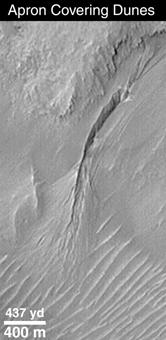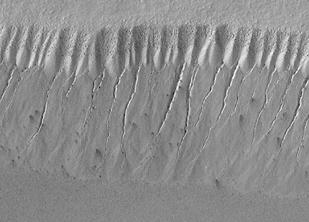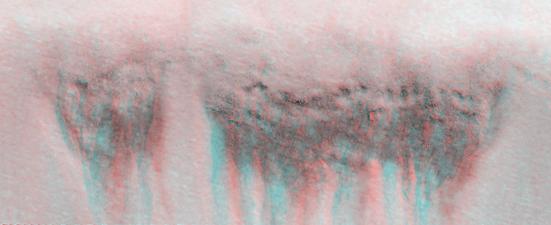 NASA Science News home |
|
 NASA Science News home |
|
|
"For two decades scientists have debated whether liquid water might have existed on the surface of Mars just a few billion years ago," said Dr. Ed Weiler, Associate Administrator for Space Science, NASA Headquarters. "With today's discovery, we're no longer talking about a distant time. The debate has moved to present-day Mars. The presence of liquid water on Mars has profound implications for the question of life not only in the past, but perhaps even today. If life ever did develop there, and if it survives to the present time, then these landforms would be great places to look." The gullies observed in the images are on cliffs -- usually in crater or valley walls -- and are made up of a deep channel with a collapsed region at its upper end (an "alcove") and at the other end an area of accumulated debris (an "apron") that appears to have been transported down the slope. Relative to the rest of the martian surface, the gullies appear to be extremely young, meaning they may have formed in the recent past.  "They could be a few million years old,
but we cannot rule out that some of them are so recent as to have formed
yesterday," Malin said. "They could be a few million years old,
but we cannot rule out that some of them are so recent as to have formed
yesterday," Malin said. Left: This picture, which was taken in September 1999 by the Mars Global Surveyor spacecraft, shows a deep, prominent martian gully in a south-facing wall in Nirgal Vallis near 29.4°S, 39.1°W. Sunlight illuminates the scene from the upper left. At the bottom of the picture is a series of evenly-spaced, almost parallel ridges. These ridges are dunes created by windblown sand. The apron--the fanlike deposit at the lower end of the deep channel--at this location is seen covering some of the dunes. The sand dunes are thus older than the apron of debris that came from the channel. The dune field has no small meteor impact craters on it, so it, like the gully landforms, is geologically young--yet older than the apron. If the dunes are active in the modern environment--which is uncertain despite the apparent youth of the dunes--then the apron would have had to form within the past few centuries or less. [more information about this picture] Credit: NASA/JPL/Malin Space Science Systems Because the atmospheric pressure at the surface of Mars is about 100 times less than it is at sea level on Earth, liquid water would immediately begin to boil when exposed at the martian surface. Investigators believe that this boiling would be violent and explosive. So how can these gullies form? Malin explained that the process must involve repeated outbursts of water and debris, similar to flash floods on Earth. "We've come up with a model to explain these features and why the water would flow down the gullies instead of just boiling off the surface. When water evaporates it cools the ground -- that would cause the water behind the initial seepage site to freeze. This would result in pressure building up behind an 'ice dam.' Ultimately, the dam would break and send a flood down the gully," said Edgett. The occurrence of gullies is quite rare: only a few hundred locations have been seen in the many tens of thousands of places surveyed by the orbiter camera. Most are in the martian southern hemisphere, but a few are in the north.  "What is odd about these gullies is that they
occur where you might not expect them -- in some of the coldest places on
the planet," Malin indicated. "Nearly all occur between latitudes 30° and
70°, and usually on slopes that get the least amount of sunlight during
each martian day." "What is odd about these gullies is that they
occur where you might not expect them -- in some of the coldest places on
the planet," Malin indicated. "Nearly all occur between latitudes 30° and
70°, and usually on slopes that get the least amount of sunlight during
each martian day." Right: Evidence for Recent Liquid Water on Mars: Gullies at 70°S in Polar Pit Walls. Gully landforms proposed to have been caused by geologically-recent seepage and runoff of liquid water on Mars are found in the most unlikely places. They typically occur in areas that are quite cold--well below freezing--all year round. Like the old adage about moss on trees, nearly all of them form on slopes that face away from sunlight. Most of the gullies occur at latitudes between 30° and 70°. [more information about this picture] Credit: NASA/JPL/Malin Space Science Systems If these gullies were on Earth they would be at latitudes roughly between New Orleans, Louisiana, and Point Barrow, Alaska, in the northern hemisphere; and Sydney, Australia, to much of the Antarctic coast in the south. The water supply is believed to be about 100 to 400 meters (300 to 1300 feet) below the surface, and limited to specific regions across the planet. Each flow that came down each gully may have had a volume of water of, roughly, 2500 cubic meters (about 90,000 cubic feet) -- about enough water to sustain 100 average households for a month or fill seven community-sized swimming pools. The process that starts the water flowing remains a mystery, but the team believes it is not the result of volcanic heating. "I think one of the most interesting and significant aspects of this discovery is what it could mean if human explorers ever go to Mars," said Malin. "If water is available in substantial volumes in areas other than the poles, it would make it easier for human crews to access and use it -- for drinking, to create breathable air, and to extract oxygen and hydrogen for rocket fuel or to be stored for use in portable energy sources."
 Above: This 3D view of v-shaped "seepage" scars on the western wall of a 50 km-diameter impact crater in southern Noachis Terra at 65°S, 15°W requires red-blue 3D glasses for proper viewing. [more information about this image] Credit: NASA/JPL/Malin Space Science Systems "This latest discovery by the Mars Global Surveyor is a true
'watershed'--that is, a revolution that pushes the history of water on
Mars into the present," said Dr. Jim Garvin, Mars Program Scientist, NASA
Headquarters. "To follow up on this discovery we will continue the search
with Mars Global Surveyor and its rich array of remote sensing
instruments, and in 2001, NASA will launch a scientific orbiter with a
high spatial resolution middle- infrared imaging system that will examine
the seepage sites in search of evidence of water-related minerals.
JPL manages the Mars Global Surveyor Mission for NASA's Office of
Space Science, Washington, DC. Malin Space Science Systems built and
operates the camera system. JPL is a division of the California Institute
of Technology, Pasadena, CA. |
| Web Links |
|
Mars Global Surveyor Home Page - from NASA/JPL Malin Space Science Systems -- MSSS operates and processes data from
instruments on planetary missions under contract to the National
Aeronautics and Space Administration (NASA). Martian Swiss Cheese -- March 9, 2000. New pictures from NASA's
Mars Global Surveyor spacecraft show exotic terrain made of dry ice near
the Red Planet's south pole. Search for Life on Mars will Start in Siberia -- May 27, 1999. NASA funds permafrost study to support astrobiology research. |
|
Join our growing list of subscribers - sign up for our express news delivery and you will receive a mail message every time we post a new story!!!
 Headlines Headlines
|